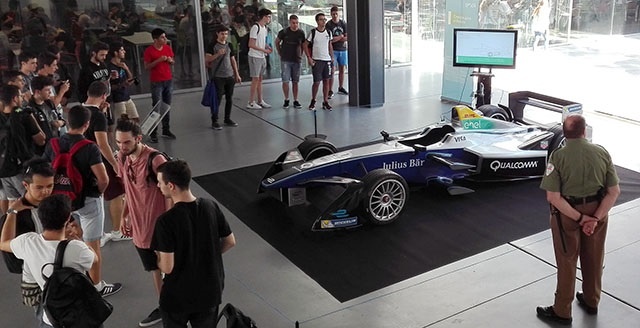One of the teams of the Formula E -electric Formula 1- which is conducting a collective preseason test at the facilities of the Circuit Ricardo Tormo of Cheste is exhibited until next Thursday 5th at the School of Engineering (ETSE). It is a collaboration between ENEL-ENDESA and the Universitat de València (Research Institute on Robotics IRTIC-ETSE).
People interested in the world of motor and energy efficiency have this week the opportunity to get to know the world of the Formula E competition thanks to the cooperation between the Group LISITT of the University Research Institute on Robotics and Information and Communication Technologies, at the Scientific Park, the ETSE and ENEL-ENDESA, the provider of the power infrastructure of the Formula E.
The Universitat already exhibits the ENEL’s official car in the Ciurcuit Ricardo Tormo in Cheste, before its 4th competition year.
Formula E is an exclusive competition category for electric single-seatings, organised by the International Automobile Federation (FIA). The idea emerged five years ago from the FIA with a challenge for companies in the automotive sector around the world: joining a car race completely electric and therefore sustainable. Brands such as McLaren, Audi, Renault or Michelin, among others, participate in this competition which seeks to promote sustainable mobility, promoting the popularity of this technology and acting as a laboratory for R & D and innovation for electric cars.
The main characteristic of Formula E cars is that they are made up of modules. That makes it easier for different teams to work on new technologies each season to apply to the vehicle separately, that is, without having to modify its complete structure.
Each car carries a 200 kg-weight battery (the same for all, provided by Williams), made up of lithium-ion cells that are recharged only by environment-friendly glycerine-powered generators. Each battery provides 28Kwh of energy. According to the competition rules, the use is limited: 200 kW during the classification and 170kW during the race. Up to now there was necessary to use two single-seatings to end the race, but now thank to several progresses in the field it will not be anymore.
To transform electrical energy into mechanics, Formula E vehicles feature a module consisting of an inverter, an electric motor and a transmission (the former converts the direct current supplied by the battery into alternating current and sends it to the motor. Through the transmission it provides mechanical energy to the tires). Since the second season, each team has been able to develop this module with total freedom, which has led to interesting innovations, such as the Nextev single gear double engines or the simple two-speed engine designed by Renault, very useful for the development of future electric vehicles.
This approach of the Universitat de València to Formula E is one more action in the line of commitment that the academic institution has with energy efficiency and sustainability. The Universitat de València is part of the EIT Climate-KIC Spain, in the department of energetic efficiency and sustainability. Climate-KIC is the main initiative public-private of the EU about the climate change.


